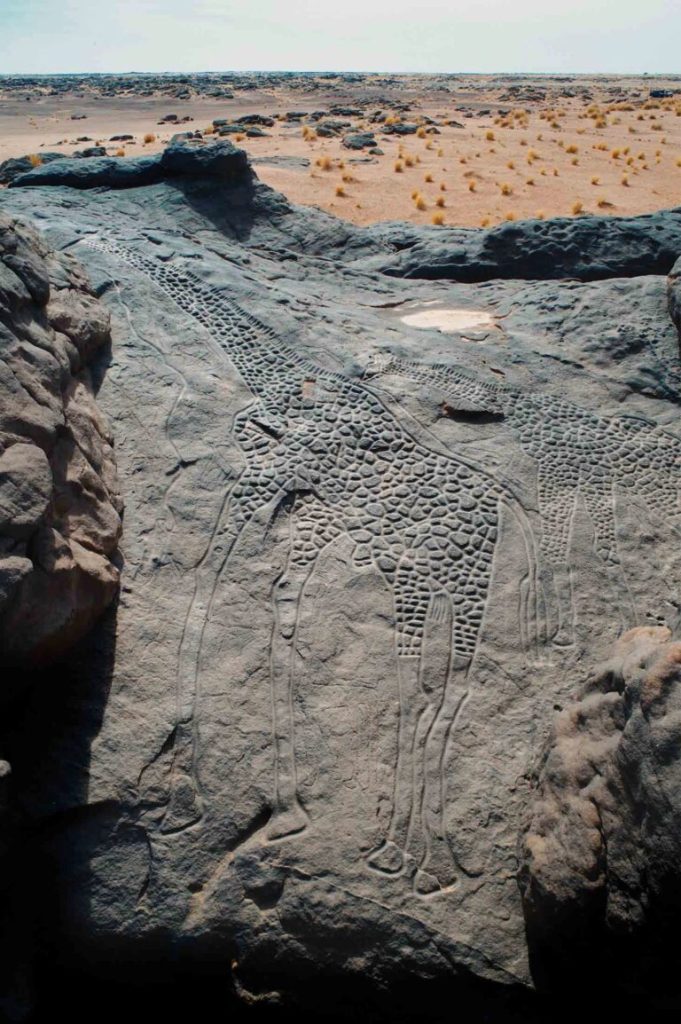In the vast and often unforgiving expanse of the Sahara Desert, there exists a remarkable legacy—a tribute to the imagination and ingenuity of our ancient ancestors. Deep within Niger’s arid landscape, near the city of Agadez, lies one of the most breathtaking and historically significant examples of prehistoric rock art ever discovered: the Dabous giraffe carvings. These awe-inspiring images, carved into desert rock approximately 9,000 years ago, transport us back to a time when the Sahara was not a sea of sand, but a flourishing savanna, teeming with wildlife and life-sustaining water sources. These carvings are more than simple depictions of animals—they are a profound testament to the connection between early humans and the natural world that surrounded them.

The discovery of the Dabous giraffes represented a turning point in our understanding of ancient African cultures and their artistic capabilities. Found by archaeologists conducting surveys in northern Niger, these carvings quickly gained international attention for their sheer scale, precision, and cultural significance. Unlike many forms of ancient art, which are typically abstract or symbolic, these carvings display a remarkable level of realism and detail. The larger of the two giraffes measures over 18 feet in height, making it the largest known rock carving of its kind. Alongside these majestic animals are depictions of human figures, suggesting a dynamic interaction between people and wildlife that once defined life in this region.
Standing in front of these carvings today, it is difficult to reconcile the present-day desert conditions with the verdant past these images depict. But scientific evidence confirms that around 9,000 years ago, during what is known as the African Humid Period, the Sahara was a vastly different environment. Rainfall was abundant, rivers flowed freely, and diverse species of animals—including elephants, crocodiles, and giraffes—thrived across the landscape. The Dabous carvings capture this era with stunning clarity, portraying the giraffes with elongated necks, distinct coat patterns, and a grace that reveals the keen observational skills of their creators.
The craftsmanship of these carvings reflects more than artistic talent—it also highlights the technical mastery of the ancient peoples who made them. Utilizing tools fashioned from stone and perhaps early forms of metal, these artists employed a range of techniques, including pecking, scraping, and polishing the rock surface to achieve varying textures and depths. The result is an astonishingly lifelike image that not only conveys movement and form but also resonates with cultural and spiritual significance. It is widely believed that giraffes were not chosen at random for this artwork; rather, they likely held symbolic or ritual importance, perhaps representing fertility, abundance, or the spiritual guardians of the land.
Beyond their aesthetic beauty, the Dabous giraffes offer valuable insights into the social and environmental context of their creators. These hunter-gatherer communities were not isolated or primitive as often portrayed; instead, they were intimately connected to their surroundings and capable of expressing that relationship through sophisticated artistic expression. The carvings serve as a narrative, etched in stone, of a time when humans lived in harmony with nature—a reminder of the fragility and richness of ecosystems that have since vanished.
Recognizing the immense importance of the Dabous giraffes, international organizations have joined forces to preserve and protect these invaluable cultural artifacts. The Bradshaw Foundation, along with UNESCO and the Trust for African Rock Art, has played a pivotal role in these efforts. One of their key initiatives was to create precise aluminum casts of the carvings, ensuring that accurate reproductions could be studied and displayed worldwide while minimizing physical contact with the originals. Additionally, these organizations have emphasized the importance of involving local communities in preservation efforts, not only to protect the carvings but to foster economic and cultural sustainability.
A small Tuareg community now serves as the custodians of the Dabous site. These guardians guide visitors, educate them on the historical and cultural significance of the carvings, and ensure that the site remains undisturbed by those who might seek to damage or exploit it. This model of community-led conservation has proven successful, balancing the need for cultural preservation with the benefits of responsible tourism. It empowers the local population while safeguarding one of humanity’s most precious artistic legacies.
As the sands of the Sahara continue to shift, the Dabous giraffe carvings stand resilient—a silent, enduring witness to the creativity and resilience of early humans. They speak to a time when the rhythm of life was attuned to the cycles of nature, when art served not only as a form of expression but as a means of recording history, beliefs, and relationships with the environment. These carvings remind us of the enduring bond between people and the natural world—a bond that, despite the passage of millennia, remains at the core of our collective human experience.
In an age where rapid technological advancement often distances us from the natural world, the Dabous giraffes invite us to reflect on the values and wisdom of our ancestors. They urge us to consider the impact of environmental change and to honor the cultural achievements of those who came before us. By preserving such treasures, we not only protect our past but inspire future generations to value and learn from the art, ingenuity, and environmental consciousness of ancient civilizations.
So, the next time you contemplate the marvels of human history, let your mind wander to the heart of the Sahara. Picture the towering giraffes, carefully carved into stone, standing as eternal symbols of a world long gone yet forever remembered. The Dabous giraffes are more than relics—they are a story of survival, creativity, and connection, etched into the timeless sands of the desert.





